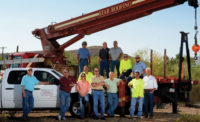Look around a jobsite, and you’ll likely see many crew members wearing Red Wing boots. They’ve been a contractor favorite for more than a century, valued for their hard-working toughness, all-day comfort and quality craftsmanship. A recently installed TPO roofing system will help ensure that the manufacturer’s 110-year-old Plant 1 building performs just as well as the company’s footwear.
Built in 1905 at the corner of Main Street and Potter Street in Red Wing, Minn., Plant 1 is the Red Wing Shoe Company’s original facility and remains an iconic landmark for the town on the banks of the Mississippi River. The building was expanded several times over the years and housed a mix of manufacturing, warehouse and administrative spaces until 2012, when it was fully converted into much-needed office space. Today, it’s part of the company’s headquarters campus and home to approximately 60 employees.
The building’s two oldest roof sections — one 7,193 square feet, the other 5,341 square feet — were last re-roofed in the early 1980s, when a four-ply built-up system was installed. The roof was patched several times over the years, but after three decades of service, the membrane began to split, resulting in leaks. Dana Chandler, owner of Chandler Roofing & Construction in Red Wing, determined that repairs were no longer a viable option and recommended replacement.
The Red Wing Shoe Company opted for a TPO roofing system for much the same reason that its customers choose its boots: long-lasting performance.
“A TPO membrane is available in a 60-mil thickness, so it will better withstand our harsh winters and sometimes-stormy summers,” said Mark Reding, maintenance and facilities specialist with Red Wing Shoe Company. “The seams are heat-welded rather than taped, which will mean fewer leaks and better wind-uplift performance.”
The company selected a white membrane — similar to those installed on other sections of Plant 1 and its other buildings — to help reduce its energy consumption and cooling costs, and help keep the employees inside more comfortable during summer months.
Chandler recommended a Mule-Hide Products TPO roofing system for its ease of installation.
“The membrane is a little more flexible than other TPO products, making it easier to work with,” he said. “It’s also easier to weld, especially when it comes to the flashing details.”
The old built-up roofing system was torn off along with the old insulation, which consisted of 1.5 inches of perlite. The perlite was nowhere near the R-23 rating currently specified by Minnesota’s Commercial Energy Code, so the team installed new insulation: 4 inches of polyiso with polyiso tapered crickets between the scupper drains.
A 60-mil-thick TPO membrane was then fully adhered to the roof deck using Mule-Hide TPO Bonding Adhesive. The crew formed its own corners using Non-reinforced TPO Flashing from Mule-Hide Products.
“If every corner was a 90-degree angle, prefabricated corners would work, but not every corner is the same,” Chandler said. “So, we form our own corners, which fit and mold much tighter, producing a better weld. It also allows us to control the size of each flashing detail.”
Reinforced Membrane Strips and Universal Single-Ply Sealant rounded out the job.
It took an eight-person crew two weeks to complete the project.
While the weight of the roof wasn’t a concern for this particular project, it’s worth noting that the new roof is significantly lighter than the old one. The new single-ply system weighs less than a pound per square foot. By comparison, the old four-ply BUR system, which had a flood coat of asphalt with an aluminum coating on top, weighed somewhere between 2 and 3 pounds per square foot with the perlite insulation. If the old roof had been installed with one-half inch of gravel as the top surface, which is common in the area, the weight would have been as much as 6 to 7 pounds per square foot.
Preserving History
Elements of the building’s original 1905 roof — including the 1.5-inch-thick tongue-and-groove roof deck and decorative Red Wing Pottery tiles — were still in place, and maintaining them required careful attention from the crew.
“We don’t often encounter century-old tongue-and-groove roof decks,” Chandler said. “Overall, the original deck was in good shape, and it wasn’t necessary to completely replace it. However, there were some areas with dry rot which we replaced with new 2-inch-by-12-inch boards.”
The ceramic tiles, each 12 to 16 inches wide, cap the parapet wall. Seen from street level on all sides of the building, their ridges complement the decorative brickwork on the structure’s upper facade and provide additional visual texture. Extreme care was taken while working around them to ensure none were broken. Typically, Chandler would have recommended removing all of the tiles before work on the rest of the project began, but the budget wouldn’t have accommodated the necessary restoration and reinstallation, or to have replacements made for any broken tiles.
So, most tiles were left in place, and the flashing was terminated at the bottom edge of the tile with a reglet counter flashing to ensure watertightness. On the lower section, tiles had to be removed because they were loose and the area underneath needed to be waterproofed. After the TPO membrane and flashing were installed, local contractor Sure Seal Restoration LLC was brought in to safely clean and reset the tiles.
“Our heritage is an integral part of who we are and what distinguishes our footwear,” Reding said. “As our original facility, Plant 1 is a significant part of that history. It was important to us to preserve it.”
Hometown Pride
The project was a source of significant hometown pride. As a major employer in the community, the Red Wing Shoe Company strives to hire local contractors.
“Red Wing has been our home for 110 years,” Reding said. “We see it as our responsibility to help this community — our family members, friends and neighbors — continue to thrive by supporting local businesses whenever possible.”
Chandler Roofing & Construction is quite familiar with the manufacturer’s facilities, having worked at Plant 1 previously, as well as at the company’s manufacturing facility (called Plant 2) and headquarters building (called Riverfront); and at Twin City Tanning Co., a tannery in South St. Paul, Minn., in which Red Wing Shoe Company owns a stake.
“It’s nice to keep the work in the community,” Chandler said. “The best part is knowing that when people come across the Mississippi River into Red Wing, they see our work.”
And, not surprisingly, Red Wing boots are a common sight on Chandler Roofing & Construction’s jobsites, worn by many of the company’s crew members.
For more information, visit www.chandlerroofingandconstruction.com, www.mulehide.com and www.redwingshoes.com.











Report Abusive Comment